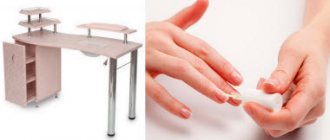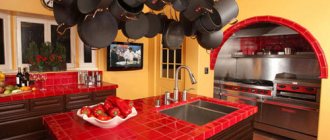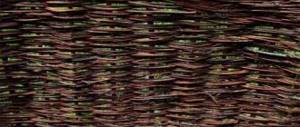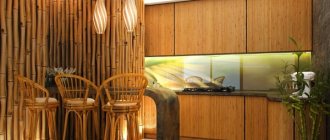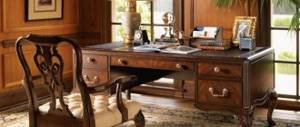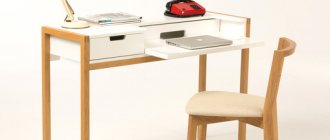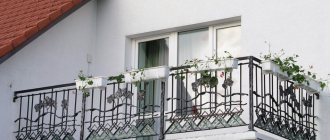Loft style table - or designer table
For a table measuring 800x1200x750 mm, you will need 3 pallets. The table shown in photo 1 will require as many as 6 pieces, and can have different configurations, since it consists of two identical modules. Having made such a couple, you can model your kitchen space in different ways.
In addition to pallets, we will need: a nail puller, a hand-held circular saw, confirmats (or nails) for fastening parts of the structure, a sander, a spatula, wood putty and paint, and varnish.
Preparation for assembly of the structure. Disassemble the pallets as follows:
- For one of them, leave only the flooring of the top and cross boards - this will be the tabletop;
- We make changes to the other two pallets (the side supports of the table) - they should be reduced in width, as indicated in Fig. 2: we separate the outer flooring boards and the rows of checkers underneath them (together with the support boards), and reduce the width of the pallet to the required size. We attach the checkers to a new place. If necessary, install the outermost flooring boards (of a different width);
- We thoroughly sand all parts of the pallets, paint their internal surfaces with stain or any water-based paint, and varnish.
We assemble a U-shaped table structure by connecting the tabletop with pallets placed on the edges and tightening them with confirmata.
For reliability, you can additionally install furniture corners on the back side of the tabletop.
We connect the central checkers of the side parts of the table with an additional crossbar made from a transverse board remaining after dismantling the first pallet.
Finishing of the structure. Carefully fill the uneven surfaces of the external surfaces of the table, paying special attention to the table top and the ends of the boards. Allow the putty to dry and sand the external structural elements again. Paint it in the desired color and cover it with two layers of varnish.
As you can see, it is very easy to make a table from pallets with your own hands - all you need is imagination and attention to detail. Try to make the table yourself from photo 2 – you’ll see, you can do it!
Step-by-step production and important tips
In order to avoid things like the proverb, “If you rush, you make people laugh,” you should forget about haste throughout the entire process. This is especially true for the template.
The countertop will also require attention. When making it, it should be remembered that to ensure symmetry it is necessary to provide small allowances for further processing with a grinding machine and rounding of corners. The main requirement for the top of the table is the complete absence of visible errors, burrs, and roughness.
In the case where it is known in advance that the product will undergo varnish treatment, when making a table from plywood, you should not use different paints. It is best to varnish the table. If you are not satisfied with the light background, you can first cover it with stain and then varnish. In this case, the unique wood texture will be preserved, which will give the finished table originality.
Sometimes other points need to be adhered to in advance. For example, when furniture can be used in damp conditions or in another aggressive environment, laminated plywood is best suited as a material for the countertop.
Such furniture will last much longer, especially when it is intended to be used in the kitchen. Also, laminated products can become quite relevant as coffee tables.
If you want to make not just a banal one, but, for example, a folding version, you should pay special attention to the fasteners. In the case when the connecting parts are made poorly, any pressure is enough for the table to become unusable.
In the manufacture of any furniture from plywood sheets, the same algorithm of actions is always used:
- First you need to draw.
- Then cut off.
- Next comes the connection of the parts using glue, self-tapping screws, etc.
- And finally, finishing. That is sanding and painting.
In fact, if you have minimal skills, such a simple product as a plywood table can be made within one day. If you have enough skills, it will take only 5-6 hours.
The main thing is that the material and consumables are of the highest quality and then everything will definitely work out.
Basic principles of working with a plywood table
In order for a product to be functional and durable, you need not only to select high-quality material, but also to assemble it correctly. If the product is assembled from pieces, then the assembly process begins only when the pieces are thoroughly dry; excess glue must be removed immediately after application so that the appearance of the product does not deteriorate in the end.
An important point is the correct drawing of the table. The distinctive feature of a plywood product should be its perfect symmetry. If you are going to cut plywood into pieces, then consider whether your jigsaw is suitable for such work. Don't forget that you will need to leave gaps for sanding and getting rid of sharp corners. When you process the material, sand it so that the surface is smooth. An important point is that, in addition to high-quality processing of the material, it is necessary to firmly fasten the parts together. To prevent cracks when screwing in the screws, drill the holes for them a couple of millimeters narrower.
To ensure that the parts are held in place as securely as possible, you can use wood glue. When you have sanded all the parts, clean them from dust, lubricate them with glue, press the parts tightly together, secure them with clamps and leave them in this position for several days until the glue has completely dried.
Advantages of the material and advantages of a plywood table
The material in the form of plywood has the advantage that it is very easy to process. Of course, the strength characteristics are inferior to solid wood, but if in the future you do not plan to use the product harshly with increased loads, a plywood tabletop can become an elegant addition to a small coffee table.
Some craftsmen with a wide imagination often make special children's tables for their children. On such a surface it is pleasant for a child to play, do crafts, do homework, and if the table breaks, it won’t take long to make a new one.
If you want to make a really durable table, you should not make it from several parts. The bottom line is that solid plywood sheets will always be stronger than even the most carefully fitted small parts.
If the table is not intended to be used in the kitchen, it would be a good idea to apply an appropriate coating, such as stain or varnish, to the tabletop. Sometimes a combination of both is acceptable.




